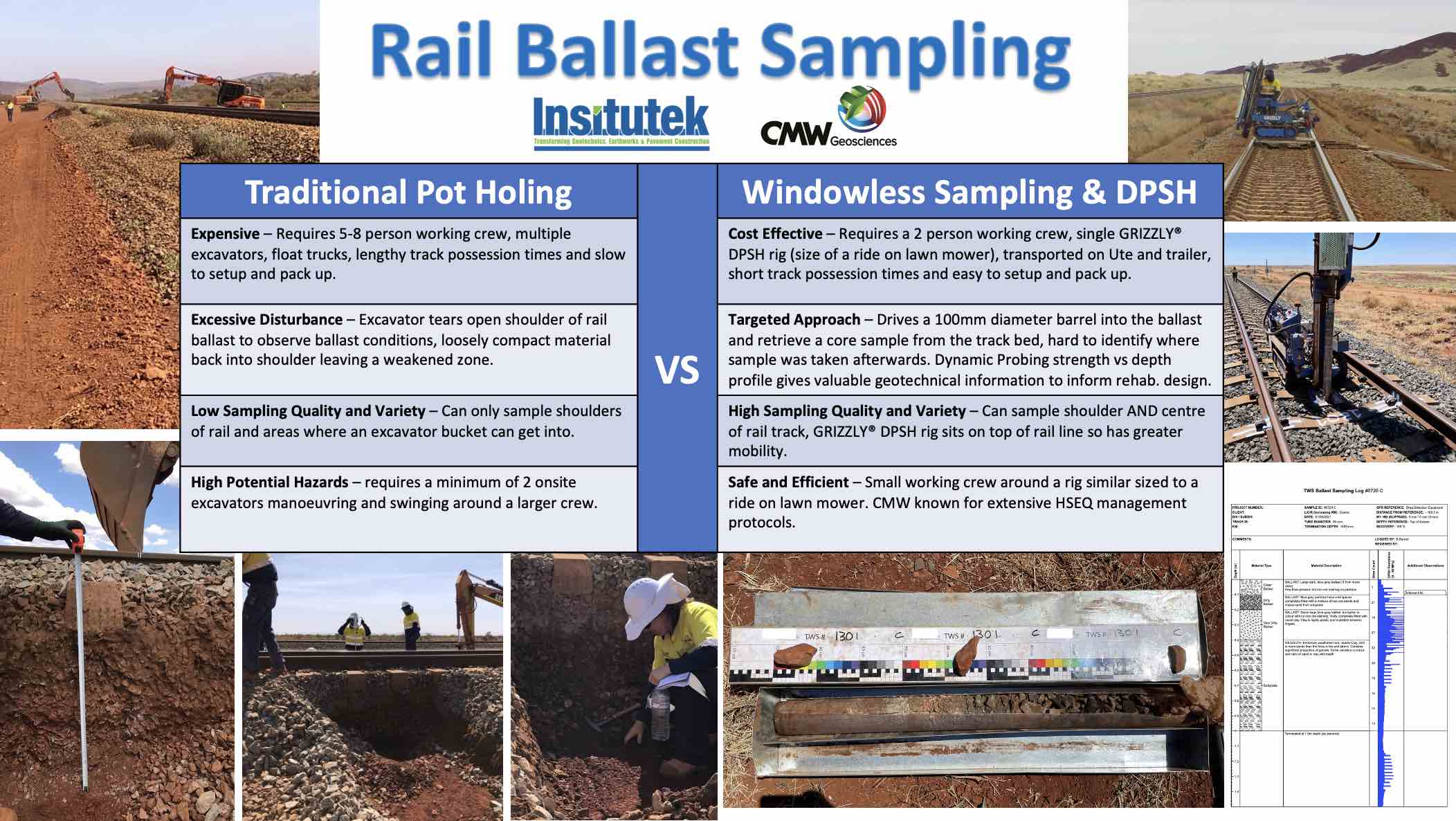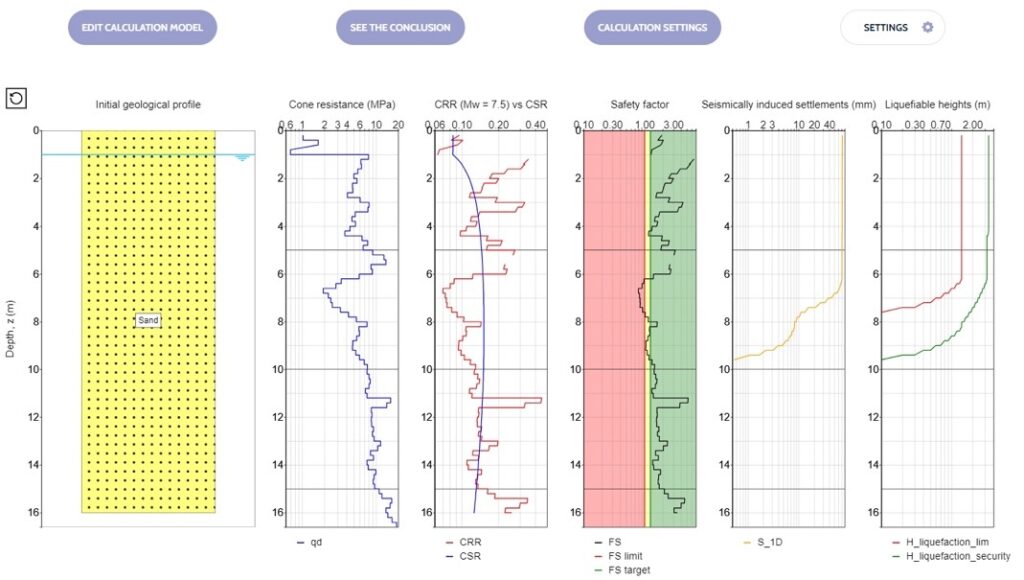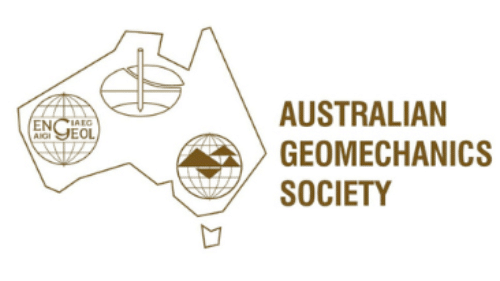Rail Ballast Fouling – An innovative technique for Material Sampling and Strength vs Depth Profiling used for Rail Tracks
Amongst rail track rehabilitation and maintenance teams, there is a constant drive to improve their ability to make better informed and more timely decisions for rail track maintenance works, including identification of underlying rail ballast and subgrade conditions. Accurate, fast and targeted identification of rail ballast and subgrade conditions at key locations allows for optimal use and planning of the rail line operation and maintenance efforts.
Why the Interest in Fouled Ballast?
When ballast becomes fouled through the build-up of fines caused by the ballast breaking down, subgrade infiltration or rail car spillage, the following occurs:
- Loss of stiffness and load bearing properties, including the ability to:
- support the axle loads applied; and
- deform elastically, rather than plasticly (permanently)
- Reduction in permeability of ballast due the increased % fines blocking drainage pathways.
Without clear information on the extent of the ballast-fouling and the subgrade condition, an overly conservative ‘Likelihood’ definition may have to be selected as part of a track functionality Risk Assessment, the result of which is often a business-critical reduction in rail track functionality and / or the application of remedial maintenance measures that may be more onerous or widespread than is actually required.
How do we Assess Ballast Fouling Currently? – Pot Holing
The Method:
The traditional method of assessing the level of ballast fouling is currently a process called pot holing. This involves bulk excavation of the trackbed ballast with an excavator bucket, often on both sides of the same sleeper, with ballast removed from about 3-4 sleepers’ width and typically to a depth just below the trackbed/subgrade interface. Samples may be taken, the material visually observed and photographed and the ballast depth measured by hand.
Once the ballast is removed, this maybe complimented with a traditional Dynamic Cone Penetrometer (DCP) test carried out on the shoulder at either end of the sleeper to understand the material strength profile into the formation (capping layer and subgrade) below the ballast.
Once completed, the removed ballast is scraped back and loosely compacted back in place. Examples of pot holing operations are shown in the photographs below.

Photos 1 to 3: Traditional Pot holing method of trackbed investigation
Logistical & Commercial Limitations / Challenges:
Pot holing requires a large crew of 5-8 people with support vehicles, multiple excavators and float vehicles to mobilise the gear to site and from site. As well as the obvious cost associated with such an arrangement, the total outlay is often increased markedly since the method typically requires long periods of track occupation time, something which detrimentally impacts the normal 24/7 operational heavy haul rail lines.
Technical Limitations / Challenges:
The pot holing investigation is in part perpetuating the underlying issue that it is intended to assess, since the method involves significantly disturbing the trackbed and subgrade in order to assess existing disturbance of the track bed. Due to the disturbance unavoidably caused by the pot holing process, the works and / or the backfilled areas reinstated have been known to present as ongoing weak zones, contributing to future operational restrictions.
Alternative Approach to Ballast Fouling Investigation: Windowless Sampling Method – GRIZZLY® Dynamic Probing Super Heavy (DPSH) Rig
Background:
Our client, CMW Geosciences, successfully carried out two geotechnical investigation campaigns along two of Western Australia’s largest Tier 1 rail lines in the Pilbara, BHP and Rio Tinto, using the GRIZZLY® DPSH rig on their heavy haul iron ore freight lines.
The Method:
The works involved investigating the underlying ballast and subgrade conditions by collect minimally disturbed ballast core samples. The windowless sampling technique used an 85mm internal diameter steel barrel, driven it down into the rail ballast using a 63.5kg percussive hammering technique dropped from a height of 760mm. This is the same constant energy driving force as the Standard Penetration Test (SPT), a test that is globally used as the standard for determining soil relative density.
The windowless sampling barrel then recovers a core sample of the rail ballast and leaves virtually no disturbance to the rail line due to the small diameter of the sampling barrel. During the campaigns in the Pilbara, every test location was quickly and effectively backfilled to the Client’s required level of reinstatement using clean rail ballast.
The Logistical and Commercial Advantages:
Photo 4 below shows an example of the windowless sampling technique in action, having tracked a short distance from a crossing point in the background. Photo 5 illustrates the set-up when short tracking distances between the rails is either impractical or unsafe, comprising rated loading ramps and a custom designed and built platform to fit between the regionally specific gauge. The GRIZZLY® DPSH rig is 900kg, 2m long and 900mm wide which can be transported to site by a single utility (Ute) and trailer.
Unlike the traditional pot holing methods, the windowless sampling technique requires only a 2-person operating crew (excluding client supervisor and Track Protection Officers). The GRIZZLY® also allows for collection of rail shoulder AND centre of rail sampling which is not possible using traditional pot holing methods. The technique is safe and quick, taking less than 30mins per location to set up the rig, advance the sampling barrel, recover a high-quality sample and backfill the sample hole.
Although the targeted GRIZZLY® Windowless Sampling approach is inherently less expensive to deploy than the traditional pot-holing cavalcade, it is when one considers this more cost-effective solution in the context if its enhanced quality of sample recovery, higher rate of productivity and smaller footprint that one truly begins to see the holistic advantage:
- Less overall disturbance
- Smaller carbon footprint
- Lower cost
- Higher productivity
- Higher quality of information

Photos 4: GRIZZLY® without platform

Photo 5: GRIZZLY® with platform
The Technical Advantages:
The figure below shows an example of the core samples collected from windowless sampling. An accurate representation of the clean ballast, fouled ballast and underlying subgrade profile with minimal disturbance of the sampled trackbed ballast/subgrade interface and equally minimal impact on the rail line. The GRIZZLY® also allows sample to be recovered between the rails, which pot-holing is not able to safely provide.

Photos 6: Ballast & subgrade sample recovered using GRIZZLY® windowless sampling
Further Technical Advantages: Dynamic Probing Super Heavy (DPSH) Technique into the Rail Ballast
Additionally, one of GRIZZLY® DPSH rig’s capabilities is conducting Dynamic Probing Super Heavy testing, which is a widely used geotechnical investigation method in Europe and increasingly in Australia and New Zealand. This method involves driving a fixed cone end rod into the ground using the SPT like percussive driving force.
DPSH data is captured electronically and is visible (numerically and graphically) as testing is carried out. The depth of every blow is recorded automatically and results can be plotted as a cone resistance (qd) or blows per 10, 20 or 30cm (N10, N20 and N30) etc, real time so you can see the strength or density representation of the underlying ground conditions along the entire depth of the test.
This combination of both innovative methods enables accurate representation of the strength or density vs depth profiling using the windowless sampling and DPSH capabilities. Generally, windowless sampling and recording blows/100mm penetration would be used but in areas requiring higher accuracy, DPSH testing can be undertaken for additional information comparison.
The DPSH cone resistance values correlate similarly with Cone Penetration Test (CPT) outcomes. However, CPT testing is not practical in this situation as the ballast material is very stiff and a continuous push using a CPT would not be possible. Hence the dynamic energy of the DPSH test is required to penetrate through the material.
Ballast Sampling Project Completed: Pilbara, 2021
One CMW Geosciences project was carried out over 14 days and sampling was taken across the one of the major rail lines. Due to the small crew and low mobilisation requirements, it was easy to organise accommodation at the mine camps and be on the move across the sampling programme. 28 locations were nominated by the client with 2-3 tests carried out at each location. Windowless sampling was carried out at each shoulder and one sample at the centre of the rail line. Note: Testing in the centre of the track is not possible with pot holing.
The second project was carried out over 9 days. 18 locations were nominated by the client with 2-3 tests per location.
During both projects, a Ute and trailer was used to mobilise the 2 person crew, GRIZZLY® DPSH rig, equipment and consumables. At each location, the GRIZZLY® DPSH rig could track onto the rail line via steel ramps and centre itself within the rail track using an easy to construct temporary platform specifically engineered for these works by CMW. This setup is shown in the Photo 7 below.

Photos 7: Expanded photo showing GRIZZLY® access ramp and platform set-up
An experienced and qualified CMW Geotechnical Engineer both operates the GRIZZLY® DPSH rig and observes the windowless core samples and log them onsite and immediately after sample collection. The logging would follow widely used rail track ballast standards identifying key ballast layers such as:
- Clean Ballast
- Slightly Dirty Ballast
- Dirty Ballast
- Very Dirty Ballast
- Underlying Subgrade
An example DPSH log is shown in the Figure below. These logs are easy to interpret, share and use for designers. A correlation from the blow counts/100 penetration and DPSH test results can also be observed.

The Pilbara is a very harsh operating environment with temperatures regularly in excess of 35 degrees during the day with low levels of humidity. The GRIZZLY® presented no mechanical issues throughout the works and the ease of operation of the unit allowed for a more sustainable progression of works, with both operatives and Client confident each day that the intended rates of progress could be achieved.
Track possessions were booked in advance and were typically 2 hrs allowed per location. Core samples can be logged by one person while the GRIZZLY® DPSH rig operated by the other person.
Borehole logs can be generated daily and onsite using CMW’s tablet pLog software and the Bentley OpenGround programme. A major advantage of the pLog software is that it only needs to sync once and anyone from CMW can access the information within minutes. This allows for very quick production of reviewed logs and meaningful daily progress updates.
Summary
This windowless sampling method provides shallow and accurate borehole logs (detailing ballast condition, depths and noticeable geotechnical conditions) more safely, at a lower cost, at a faster rate , at a higher quality and in a less destructive way when compared to traditional pot holing methods.
Traditional Pot Holing Investigation |
Windowless Sampling & DPSH Investigation |
Expensive – Requires 5-8 person working crew (excluding client supervisor and Track Protection Officer), multiple excavators, float trucks, lengthy track possession times and slow to setup and pack up. |
Cost Effective – Requires a 2 person working crew (excluding client supervisor and Track Protection Officer) crew,, single GRIZZLY® DPSH rig (size of a ride on lawn mower), transported on Ute and trailer, short track possession times and easy to setup and pack up. |
| Excessive Disturbance – Excavator tears open shoulder of rail ballast to observe ballast conditions, loosely compact material back into shoulder leaving a weakened zone. | Targeted Approach – Drives a 100mm diameter barrel into the ballast and retrieve a core sample from the track bed, hard to identify where sample was taken afterwards. Dynamic Probing strength vs depth profile gives valuable geotechnical information to inform rehab. design. |
| Low Sampling Quality and Variety – Can only sample shoulders of rail and areas where an excavator bucket can get into. Samples are regularly disturbed to the extent that the purpose of the investigation is nullified and inaccurate or overly conservate estimation is required |
High Sampling Quality Sampling Variety – Sample quality is high, with an uninterrupted profile of clean ballast to subgrade achievable allowing an accurate assessment of trackbed condition to be undertaken. Can sample shoulder AND centre of rail track, GRIZZLY® DPSH rig sits on top of rail line so has greater mobility. |
| High Potential Hazards – requires a minimum of 2 onsite excavators manoeuvring and swinging around a larger crew | Safe and Efficient – Small working crew around a rig similar sized to a ride on lawn mower. CMW known for extensive HSEQ management protocols. Not labourer intensive and requires no excavator swinging movement. |
| Slow – Can be time consuming to setup, complete the works and conduct remedial works on the pot holed area | Quick – Each sample requires 20-30 minutes of testing time and can collect 3 samples within 2 hour track possession |
If this has article has stimulated your interest in exploring Windowless Sampling and DPSH investigation further, please contact us to discuss further.
Our Plate Load equipment is getting a lot of use. We’re very happy with it. 🙂
Insitutek imports, sells and services, unique geotech equipment that has proved of great benefit to those who use it. It has a particularly beneficial role to play for those compacting soil in infrastructure projects.
I would hate to go back to doing the Plate Load Test using the old method using dial gauges. It would be so time consuming, not to mention manually recording and then processing all the results.
Insitutek Blogs
We find clients are often looking for ways to improve geotechnical testing outcomes and do it more efficiently at the same time. This drives their buying decision making. Australian Soil and Concrete Testing (ASCT) was a case in point when they were searching for Plate Load Test equipment for their upcoming Collector Wind Farm project. Some of the things that motivated them include: […]
We are excited to introduce the addition of a new Liquefaction Risk Estimation module in WebSprint©. Paired with our cutting-edge products, PANDA® and GRIZZLY®, this module enables you to assess the liquefaction risk of soils exposed to seismic stress. PANDA® Instrumented DCP: This cutting-edge tool provides dynamic penetrometer soundings, delivering precise data crucial for seismic risk evaluations. GRIZZLY® […]
The Australian Geomechanics Society is gearing up for a series of geotechnical events across VIC, WA, NSW, and SA-NT. We are thrilled to inform you that we will be sponsoring and attending these exciting geotechnical events, and we would love for you to join us. It’s a fantastic opportunity to catch up, explore our booth (VIC), and stay informed about […]




